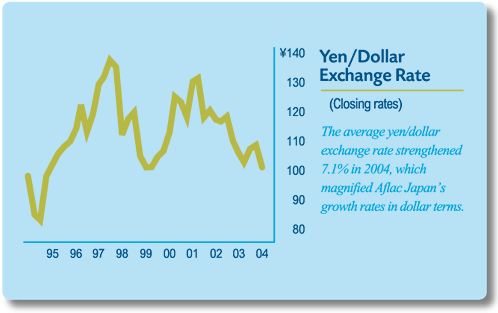 |
Aflac Japan celebrated its 30th year of operations in 2004. Over the last three decades, many aspects of Japan's business environment have changed, including the economy, demographics, and competition — but Aflac Japan has successfully negotiated those changes by staying focused on providing consumers with the best supplemental insurance value.
We had other reasons to celebrate in 2004. Our persistency improved over 2003 levels, and new money investment yields were higher than we had anticipated. Aflac Japan maintained its position as the number one insurance company in terms of individual policies in force and as the leading seller of cancer life and medical insurance policies. However, our new annualized premium sales fell short of our target for the year. New sales were up 1.1% to ¥122.5 billion, or $1.1 billion, for the year. Despite slower sales growth, our financial results were strong and met or exceeded our expectations for the year. Below are some highlights for 2004:
- Premium income rose 6.7% to ¥905.2 billion, compared with ¥848.1 billion in 2003.
- Total revenues increased 6.0% to ¥1.1 trillion, compared with ¥1.0 trillion the previous year.
- Pretax operating earnings rose 14.9% from ¥132.2 billion in 2003 to ¥152.0 billion in 2004.
Aflac Japan generates more than 70% of total revenues and pretax operating earnings. Because of Aflac Japan's size, fluctuations in the value of the yen can significantly affect our results as reported in dollars. Aflac Japan collects premiums in yen, pays benefits and expenses in yen, and holds yen-denominated assets to support yen-denominated liabilities.
Currency changes do not affect Aflac in economic terms because, with the exception of a limited number of transactions, we do not convert yen into dollars. However, for financial reporting purposes, we are required to translate Aflac Japan's income statement from yen into dollars using an average exchange rate.
When translating Aflac Japan's results from yen into dollars, growth rates are magnified in dollar terms when the average yen/dollar exchange rate is stronger than the preceding year. On the other hand, growth rates in dollar terms are suppressed when the yen is weaker to the dollar than the preceding year. In 2004, the yen averaged 108.26 to the dollar, or 7.1% stronger than the average of 115.95 in 2003. The stronger yen enhanced our reported results in dollars as reflected below.
- Premium income rose 14.2% to $8.4 billion, up from $7.3 billion in 2003.
- Total revenues were up 13.4% to $9.9 billion, compared with $8.8 billion in 2003.
- Pretax operating earnings increased 23.1% to $1.4 billion from $1.1 billion in 2003.
Even after 30 incredible years, Japan remains a significant market that is expanding as a result of changes in the economy and demographics. Health care costs have been steadily rising, stressing the national health care system.

|
 |



